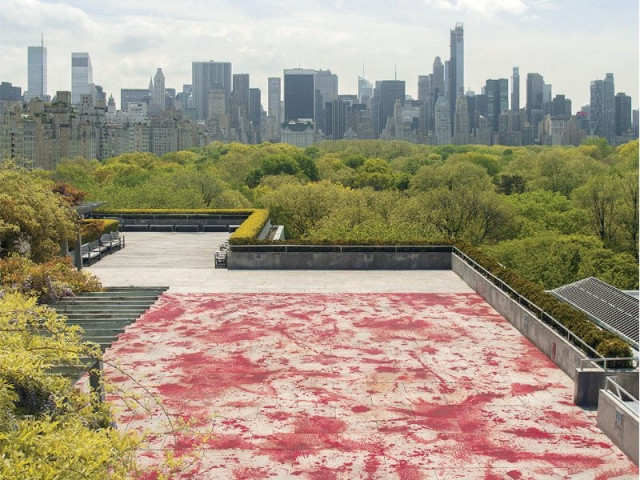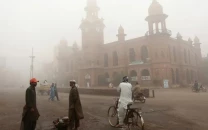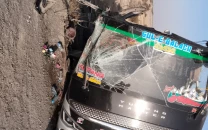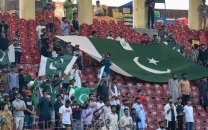Art at its peak: Don't Look Down
Paksitani artist Imran Qureshi is invited to paint the roof of the world’s most prestigious art museum.

Paksitani artist
Imran Qureshi is invited to paint the roof of the world’s most prestigious art museum.
Qureshi is a celebrated artist who was born in Hyderabad in 1972. He was trained as a traditional miniaturist in the classical Persian style of finely detailed paintings (1526–1857) made so famous by the Mughal courts. But here, he has spread himself too thin by aiming to transform a space that measured 8,000 sq ft.

“And How Many Rains Must Fall Before the Stains are Washed Clean”
-Installation by Imran Qureshi, 2013, acrylic.
COMMISSIONED BY THE METROPOLITAN MUSEUM OF ART, NEW YORK FOR THE IRIS AND B GERALD CANTOR ROOFGARDEN.
© imran qureshi and the METROPOLITAN MUSEUM OF ART, NEW YORK
The result is an endeavour that appeared to want to hit all the right notes or a checklist of obvious metaphors associated with violence. Red — check. The Muslim artist’s visual language crossed with ritual sacrificial iconography — check. Hope depicted through blossoming leaves — check.

“Blessings Upon the Land of my Love”
Imran Qureshi, 2011
acrylic and emulsion paint on interlocking brick pavement
Biennial, Commissions & Productions sharjah art foundation
© imran qureshi and ALFREDO RUBIO
His greatest weakness was, however, the site he was working with. The acrylic paint splashed across the space was more Jackson Pollock than Miniature Art. As a result, I would argue that the space wasn’t transformed; it was just painted upon. A comparison with his earlier piece ‘Blessings Upon the Land of My Love’ for the Sharjah Biennial in 2011 illustrate the weakness of his current exhibit. That space was the courtyard of Beit Al Serkal. The miniaturist in him took to the grid that already existed and worked with it. His visual language emerged with the intricacies of the traditional 16th and 17th Century style that he was trained in. The context, both in terms of the Middle East, and his visual language, were apt. The motifs were derivative of the same region and their shared history of violence gave them depth. The use of red, though obvious, was impactful enough to have a transformative effect. The courtyard of the gallery (formerly a residential space) became reminiscent of a mosque: a space for ritual engagement with God who then leaves room for hope.

“wuzu 2”
imran qureshi, 2006
acrylic and emulsion paint on walls and tiled floor
masjid sultan, singapore biennale, singapore
© imran qureshi and corvi mora, london
But then Qureshi departed from this approach and went the way of Muslim artists who have chosen to represent their countries torn apart by violence to the Western audience. For The Met he stuck to red even though the palette was really just a mix of US-Pakistan diplomatic relationships, 9/11, drone strikes, the Boston bombings.

“Blessings Upon the Land of my Love”
Imran Qureshi, 2011
acrylic and emulsion paint on interlocking brick pavement
Biennial, Commissions & Productions sharjah art foundation
© imran qureshi and ALFREDO RUBIO
Hope cannot be represented by lush foliage in a land where there is such little rain. To do true justice to the complexity of violence, the visual language has to be pushed to similar extremes.
The piece falls flat. Literally.

“They shimmer still” imran qureshi, 2013
gold leaf and acrylic on canvas, diptych, each 280 by 205 cm
© courtesy: imran qureshi and corvi mora, london
The exhibit will be open from May 14 to November 3
Published in The Express Tribune, Sunday Magazine, June 2nd, 2013.
Like Express Tribune Magazine on Facebook to stay informed and join the conversation.



















COMMENTS
Comments are moderated and generally will be posted if they are on-topic and not abusive.
For more information, please see our Comments FAQ